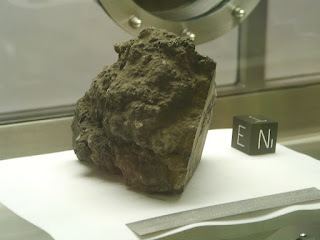The centre was purpose-built for the Apollo space program in a new suburb on the southern fringe of Houston. Decades later it’s still the hub of NASA’s manned space program. Currently, it's home to the nation’s astronaut corps, the International Space Station's operations, and the Orion program tasked with sending astronauts back to the moon.
In February 2005, Garry and I spent two days in the Houston area soaking up the best of NASA while sampling a few of the region’s other tourist attractions. We flew into Houston shortly after 11:00am, collected our rental car, and made our way south. Our first stop for the day was Galveston, an historic city built on a coastal barrier island in the Gulf of Mexico.
The city’s natural harbour, Galveston Bay, is the heart of the Texan offshore oil drilling industry. In the harbour you'll find all manner of hardcore infrastructure including massive oil rigs, refineries, and industrial ships. However, Galveston is probably better known for a devasting hurricane that struck the city on 8 September 1900. The storm flattened the city and killed an estimated 8,000 people. This tragic event still holds the record as the USA’s most deadly natural disaster.
Garry and drove out to the city’s eastern limits to explore the 16-kilometre-long, 5.2-metre-high, seawall that was built to protect it from future floods and hurricane storm surges. The entire island and the nearby mainland are incredibly flat - and remain so for miles inland. It’s easy to see how these low-lying areas could become inundated by surging water.
While in Galveston we also visited the Ocean Star Offshore Drilling Rig and Museum. This fascinating decommissioned structure lets you explore the workings of a real offshore rig. A series of models and interactive displays inside the structure explain how oil is found, exploited, and brought ashore. Outside visitors can check out its hallmark derrick and drill string infrastructure. All in all, it was an excellent experience.
The following morning, we made our way to the Johnson Space Center (JSC) for a full day of NASA nerdiness. The centre offers a series of guided tram tours through the actual working complex. Visitors can choose from three itineraries. We booked two of them.
The first tour took us into the centre’s historic Mission Control Center (where the Apollo program was once controlled) while the second took us into JSC's astronaut training facility (formerly called the Jake Gam Mission Simulator and Training Facility until the Shuttle program ended. Jake Gam was a senator who flew in space on the Shuttle in 1985).
Our visit to the Astronaut Training Facility was a real highlight. Here we watched real astronauts training for future shuttle missions. Visitors are herded into a gantry-level room with a bank of windows that look across an enormous facility filled with all manner of life-size mock-ups of the shuttle and International Space Station. Garry and I totally geeked out with everything that was on display.
Sadly, we didn’t get to see the JSC's Saturn V moon rocket. A scheduling clash with the daily tram tours forced us to choose between the training facility tour we ultimately booked and a stop at the rocket park. I consoled myself with the fact that I’d already seen a Saturn V in Florida at the Kennedy Space Centre, and again at the U.S. Space & Rocket Center in Huntsville.
Our final hours in Houston were spent visiting the Kemah Boardwalk. This is a lively seafront venue filled with amusements and restaurants. We booked ourselves in for dinner at Aquarium, a large surf and turf restaurant whose walls are taken up by a huge fish tank filled with tropical sea creatures. The tank also featured a rather intimidating reef shark. We then headed back to the airport for a late-night flight back to Dallas.
The following morning we flew back to Sydney via LA. However, our departure from the USA wasn’t all smooth sailing. As we checked in we were unexpectedly asked to pay additional charges. After a heated argument across the counter, we cough up more money before our boarding passes were finally issued.
We later learned that our travel agent hadn’t processed a series of airline fees correctly on our tickets. However, we’re still at a loss to explain why this error wasn't picked up until our final flight home. Even more so considering we'd already flown five flights on the same ticket in the preceding two weeks.


























No comments:
Post a Comment